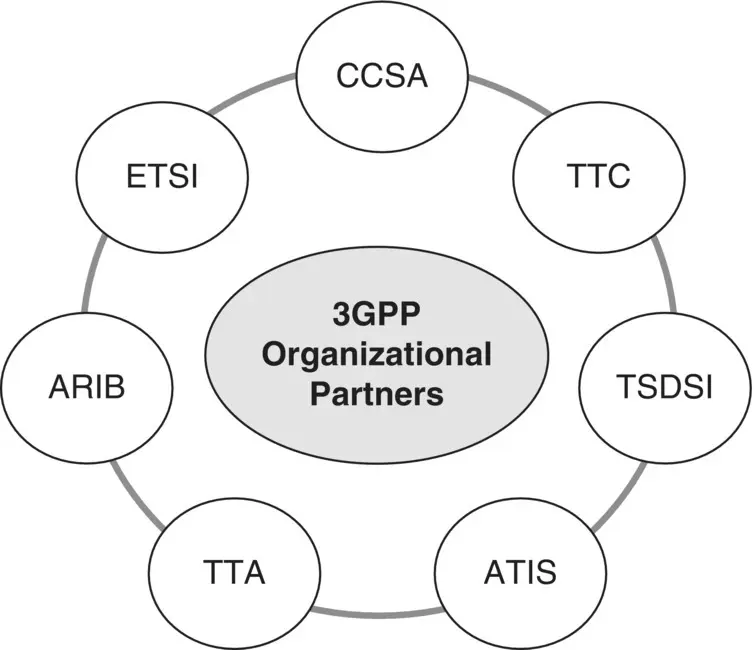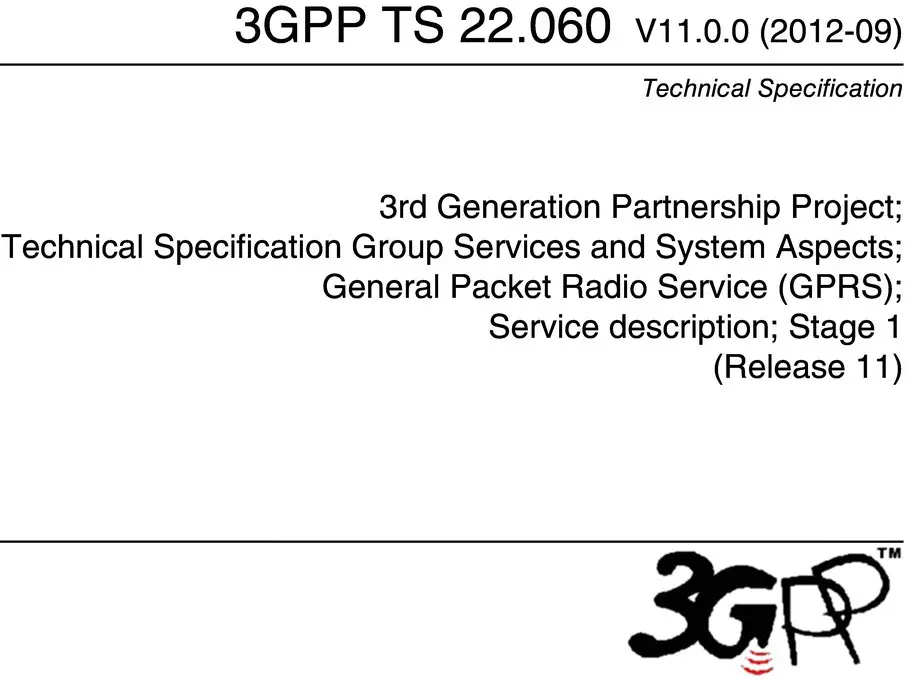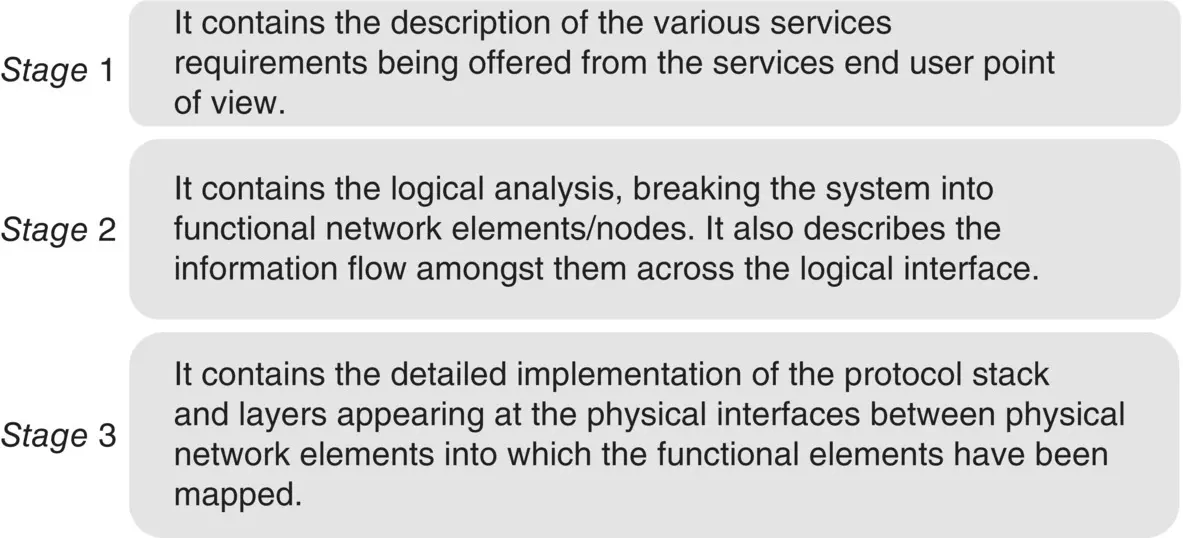2.5 Standardizations of Mobile Communications Networks
2.5.1 3rd Generation Partnership Project (3GPP)
In the preceding sections, we have discussed mobile communications network architectures along with their various network elements which are based on the GSM, UMTS, LTE, and 5G technologies. The interconnected network elements, either from the same or different OEM(s), provide end‐to‐end mobile communications and broadband services to subscribers. A network element communicates with another network element(s) through a standard protocol like the different PCs, and servers use Transmission Control Protocol/Internet Protocol (TCP/IP) and other protocols to communicate with each other over the Internet. There are international bodies that define and standardize various standard protocols such as TCP/IP, File Transfer Protocol (FTP), and Internet Control Message Protocol (ICMP). Similarly, the protocols and architectures used in a mobile communications network with interconnected network elements are defined and standardized by an organization called 3rd Generation Partnership Project , shortly called as 3GPP . It is a collaborative effort among different organizational partners. Those partners are ARIB, ATIS, CCSA, ETSI, TTA, TTC, and TSDSI, which are regional and national standards bodies, from Asia, Europe, and North America. See Figure 2.15.
The 3GPP and its organizational partners develop and standardize the architectures and protocols used in a mobile communications network. In a nutshell, start visiting the 3GPP site [1] right away to learn more about the 3GPP and its structures and crawl through the various information available under the different pages. The 3GPP site contains all the required information which is a key to know about the standardization processes of mobile communications systems and networks and their network elements that span across its different system engineering areas. A mobile communications network, consisting of the system engineering areas shown in Figure 2.14, that is conforming to 3GPP specifications is said to be a 3GPP compliant communications system.

Figure 2.15 3GPP organizational partners/members.
2.5.2 3GPP Working Groups
Within the 3GPP, there are four technical specification‐working groups (TSG) dealing with a particular area of work. Those groups are:
RAN,
Service and Systems Aspects (SA),
Core Network and Terminals (CT), and
GSM EDGE Radio Access Network (GERAN).
Each of the above areas/groups has further subgroups, such as RAN1, RAN2, RAN3, RAN4, RAN5, and SA1 to SA6, depending on a work area. For details, visit the specification group link on the 3GPP site [4] to know about the different working groups and their area of responsibilities. There is a table named “Project Co‐ordination Group (PCG)” containing hyperlinks for various working groups which could be explored further by clicking on the same. 3GPP specifies:
Maintenance and evolution of radio access technologies starting from GSM (2G) to 5G and beyond.
Maintenance and evolution of core network and system architecture starting from GSM (2G) to 5G and beyond.
Service layers such as GSM Services and IMS.
2.5.3 3GPP Technical Specification and Technical Report
In our day‐to‐day life, we use different electronic gadgets just in a plug and play way. Similarly, one can remove a SIM card from a phone, insert it into another phone with a different make and model, and start using it. All these are possible only when those devices are designed and works based on certain standards/protocols. The network elements of a mobile communications network are also designed and work on certain protocols as defined by the 3GPP. A particular protocol layer, and its various aspects, as defined by the 3GPP, is identified under a standard terminology called “ Technical specification ”, or “ TS ” in short. There is another terminology called “ Technical Report”, shortly called as “TR ”. A TR is for an informational purpose which is the result of a study phase/item on a particular area. A TR, later on, may lead to a technical specification. A technical specification is a standard specification as a result of a work item based on a TR.
A sample cover page of a 3GPP technical specification is shown in Figure 2.16. Look at the information that is available on the cover page of a 3GPP technical specification; see Figure 2.16. For example, 3GPP TS 22.060: “General Packet Radio Service (GPRS); Service Description; Stage 1” and 3GPP TS 23.060: “General Packet Radio Service (GPRS); Service Description; Stage 2”; and so on.
To decode and derive the relevant information, one must be aware of the nomenclature being used to identify a TS. Meaning and decoding of the various information available in 3GPP technical specifications are described in the subsequent sections of this book. Visit the 3GPP site [2] to get familiarity with the nomenclature. Knowing the nomenclature and picking the correct 3GPP TS is very important from the conformance point of view.

Figure 2.16 Example of a cover page of a 3GPP technical specification.
Source : © 2012. 3GPP ™ TSs and TRs are the property of ARIB, ATIS, CCSA, ETSI, TSDSI, TTA and TTC who jointly own the copyright in them. © 2012, 3GPP.
2.5.4 Stages of a 3GPP Technical Specification
A 3GPP technical specification may be divided into stages such as Stage1, Stage2 and Stage 3. Descriptions and purposes of each stage are shown in Figure 2.17.
In this case, the titles of the technical specifications will be the same, but they will have different specification numbers. The cover page of a sample technical specification shown in Figure 2.16shows the “Stage1” of the technical specification.
2.5.5 Release Number of 3GPP Technical Specification
3GPP technical specifications are grouped into a particular “ Release ”. A mobile communications system and the network could be developed based on the set of all the specifications that belong to a particular release. A mobile communications system and its node/element is said to be compliant or conforms to a particular release. A list of 3GPP releases available so far is mentioned later in Section 2.6. From the sample cover page of the TS 23.060 [31] shown in Figure 2.16, the corresponding release number is 11 that is derived from the version field: V11.0.0.

Figure 2.17 Illustration: different stages of a 3GPP TS.
2.5.6 3GPP Technical Specification Numbering Nomenclature
Series Number
Each 3GPP protocol layer has a unique technical specification number. An analogy to a technical specification is the Request for Comments (RFC) number, e.g. RFC 1234, defined by the Internet Engineering Task Force, of a particular protocol such as ICMP. The technical specification numbering system is like this: ab.xyz or ab.xy where the first two digits, i.e. ab , identifies the series number of the technical specification. This is further followed by either 3 digits (e.g. xyz) for series from 21 to 55 or 2 digits (e.g. xy) for series from 01 to 13. For example, consider the cover page of the sample TS 22.060, shown in Figure 2.16. The corresponding technical specification number is TS 22.060, where 22 is the series number here.
Читать дальше















